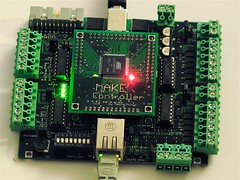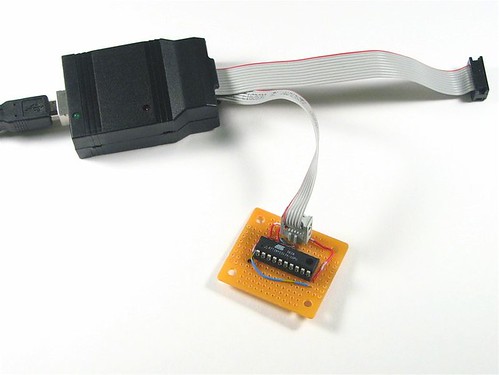
Coming up real soon now: Three microcontroller-oriented classes, on Saturday afternoons at TechShop, at different levels of skill and with different emphases:
- Sat. June 9, 1:00 PM: Make a Micro Readerboard
- Sat. June 16, 1:00 PM: Introduction to AVR Microcontrollers
- Sat. July 7, 1:00 PM: Choosing a Microcontroller
The classes are held at TechShop, a San Francisco Bay Area “open-access public workshop,” located just off of 101 in Menlo Park, where you can go use a wide range of tools to make things, and take all kinds of classes.


Make a custom LED Micro-Readerboard
Next Saturday, June 9, I’ll be giving a fun little class, suitable for anyone with a bit of soldering experience (even youngsters), where you can customize the phrases in and assemble an LED Micro-Readerboard. It’s a cute little thing that spells out a preprogrammed messages (e.g., your name), one letter at a time, on a single-character alphanumeric display. These are much like the ones that we programmed to be holiday ornaments a few months ago, but these are actually extra-spiffy version 2.0 micro-readerboards with higher brightness and better battery life. And, if you take the class, you get to choose what messages to put on your readerboard and take it home. It’s a neat, self-contained project that’s a great example of what you can do with a little AVR microcontroller.
(UPDATE: Second class added on June 30, also at 1:00 PM.)
And speaking of AVR Microcontrollers….

Introduction to AVR Microcontrollers
Saturday, June 16, 1:00 PM
You may have noticed that a number of our interesting projects are based around AVR microcontrollers. AVR microcontrollers are powerful and inexpensive single-chip computers that are available in a wide range of sizes. They also happen to be remarkably easy to program in C, using entirely free and open-source tools that run on Macs, Windows, and Unix-like operating systems. In this practical introduction to AVR microcontrollers, we’ll take it from the beginning so that you can go home and use AVRs for your own cool projects. Some topics to be covered include: different types of AVRs and how to pick one, what kinds of programmer you should get, how to install the software tools, how to get started actually programming them, and how to download and run your code on the microcontroller.
Choosing a microcontroller
Finally, on July 7, I’ll be giving a repeat of this introductory microcontroller class, called Choosing a Microcontroller. This large-format seminar is designed to be a broad introduction to the capabilities and variety of single-chip computers, as well how to actually pick one for a given application. It’s easy to get overwhelmed looking at the variety of range of micros, from four-bit micros that have a 4-bit wide data path — and actually cost four bits— to AVRs and PICs, basic stamps and Arduinos, to 32-bit gorillas with names like ARM, Blackfin, and Coldfire. So, we’ll try and cut through the fog and help you figure out where to get started.
If you’ve heard people getting excited about or doing cool things with microcontrollers and want to learn more, this might be a great introduction to the field.
Sign up for these and other TechShop classes here.
(By the way, it’s hard to tell what types of things people want to learn about. So, if you have suggestions for other classes that you’d like to see taught by the Evil Mad Scientists, you can E-mail us or leave comments here or in the forums.)















